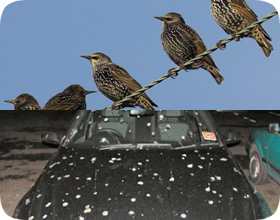- info@wildlife-removal.com
Call us for help in your town
Wildlife Removal Education
Starling Removal and Control
Need starling removal in your hometown? We service over 500 USA locations! Click here to hire us in your town and check prices - updated for year 2020.
 How to Get Rid of Starlings -
Starlings are an interesting song bird with attractive feather coloration. They have a complex communication system consisting of a wide variety of mimicked sounds. As a species they are intriguing and often subject to much interest in the bird watching community. Those who love song birds find themselves in a bit of a dilemma when it comes to starlings. While interesting in their own right, these birds are aggressive, flock feeders and will bully other song birds out of nests and feeding locations. If a murmuration of starlings appears at your feeder, you are unlikely to see any other birds until the starlings decide to leave.
How to Get Rid of Starlings -
Starlings are an interesting song bird with attractive feather coloration. They have a complex communication system consisting of a wide variety of mimicked sounds. As a species they are intriguing and often subject to much interest in the bird watching community. Those who love song birds find themselves in a bit of a dilemma when it comes to starlings. While interesting in their own right, these birds are aggressive, flock feeders and will bully other song birds out of nests and feeding locations. If a murmuration of starlings appears at your feeder, you are unlikely to see any other birds until the starlings decide to leave.
Need professional help? Click here for my Nationwide List of Starling Trappers
If starlings have become an issue for you, the first step is to do what you can to make your home less appealing for them. Take away any seed you have placed outside for other birds or replace it with sunflower seeds which starlings will not eat. Cover garbage and compost piles. If you have farm animals, be sure that any grain is locked up and under the cover of a building. Starlings will also look for nesting sites. Seal up any cracks along roofs and gutters. Place covers over vents into the home. If possible, place fine netting under eves to prevent nest building. Starlings favor bird houses with round holes. Some experts suggest modifying bird houses to have crescent shaped openings. This shape will promote bluebird and martin nesting but will discourage starlings.
Unfortunately, scare tactics are usually futile with starlings as with most other birds. Laser beams are supposed to confuse them when aimed into the murmuration. Ultrasonic pulses and electric pulse emitters make similar claims. No proven benefits have been seen from any of the above methods. Owl decoys and balloons are another favorite deterrent for problem birds. These items do not work either; they are fake, and the starlings will eventually learn that when the decoy or balloon remains stationary for long periods of time. Farmers will often try sound cannons to disperse flocks. This method can be effective, but it may not be practical for use in a suburban back yard. A cat or dog is also a temporary solution. Cats are unlikely to take on an entire population of aggressive birds, and dogs lose interest too quickly to be a reliable harassment choice. Shooting starlings may be prohibited in certain areas, and this method is time consuming and frustrating if it is allowed. There are no approved poisons for song birds. For years, areas with severe problems netted and then gassed starlings, but this tactic has come under scrutiny as inhumane. Other concerns centered on poisoned fumes blowing into areas of human population if the wind was strong. This method is still used today in spite of the ethical debate surrounding it.
Because starlings tend to be present in large groups, removal methods may be needed for dense populations. If you have a problem of this scale, contacting a professional is your best option. For smaller groups or mated pairs of starlings, a variety of traps are available that will allow you to relocate the bird after capture. One trap design features a fake bird house positioned on top of a long piece of PVC pipe. The pipe is about eight feet long and has a cage on the bottom. A starling searching for a nest site will enter the fake house, be unable to find a solid place to perch, and will ultimately end up in the bottom cage, unable to fly out. Before you relocate your captured starling, make sure the nesting sites around your property have been effectively sealed off. Starlings will return, so making these areas inaccessible is important.
Of all the song birds out there, starlings are one of the few species homeowners are allowed to legally control by removing nest sites. It is a little known fact but federal law prohibits the majority of native bird nests from being destroyed or relocated without a permit.


















